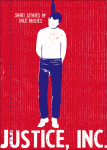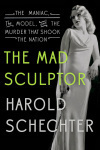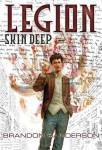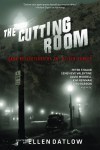Vince Darcangelo's Blog, page 8
January 31, 2015
Review: Being Mortal
Being Mortal: Medicine and What Matters in the End
Atul Gawande
I believe strongly that doctors are women and men who work in a health-care facility of some kind, including  hospitals, clinics, shelters, combat support hospitals, etc. Doctors, ahem, do not host talk shows. Medicine is a challenging, ever-evolving field of study and practice. One cannot be both a practicing doctor and a television personality.
hospitals, clinics, shelters, combat support hospitals, etc. Doctors, ahem, do not host talk shows. Medicine is a challenging, ever-evolving field of study and practice. One cannot be both a practicing doctor and a television personality.
That is, unless you are Atul Gawande.
On Feb. 10, PBS will break this rule when the Frontline documentary crew shadows the surgeon, author and New Yorker writer. The show is a tie-in with Gawande’s new book, Being Mortal, which chronicles the history and current state of end-of-life care, an issue that’s come to the fore through the proposing and passing of “death with dignity” initiatives in many states. Gawande takes us inside the nursing home, assisted living communities, to learn what these institutions are getting right and getting wrong, and to offer a view of the alternatives, such as hospice.
I have enjoyed most of Gawande’s writing, but I believe he’s surpassed his previous successes with Being Mortal. While his other books have been intimate and instructive, there is greater depth here that opens the author to his audience as never before. As the book progresses, it becomes a memoir, of sorts, of his father’s final years, a touching, factual documentation that delivers a bold-stroke illustration of his argument without overshadowing the narrative.
The focus of the book, however, is not on Gawande or his family. It is on the thousands of families struggling with end-of-life issues everyday. An indirect consequence of medical progress, Gawande argues, is that extending life has overshadowed sustaining quality of life, and in modern times, we have the luxury of distancing ourselves from our mortality.
“Technological society has forgotten what scholars call the ‘dying role’ and its importance to people as life approaches its end,” Gawande writes.
Being Mortal begins with a scholarly frame: the author calls up one of my favorite books, Tolstoy’s The Death of Ivan Ilyich, drawing attention to the relationship between the titular character and his butler, Gerasim. Without falling down the rabbit hole of Tolstoy’s existential treatise, the takeaway for Gawande is at what point do we stop pursuing cures (which agonized Ilyich) and provide comfort instead (as offered by Gerasim).
As Gawande puts it: “…it is clear that there are times when the cost of pushing exceeds its value.”
Defining when it’s that time is an uncomfortable topic, and as the author explains, it leads to many difficult conversations, but is important for the benefit of the dying as well as their caretakers.
The Frontline episode should be fantastic, as the show usually is, and will hopefully wean Americans off the junk food of television doctors Oz, Phil, et al. and snake-oil salesmen like Eben Alexander.
Instead of junk food, Gawande gives us science, history and heart in a page-turning treatise on the way we die now, and how we could do it better.

January 7, 2015
Dispatches from the War on Drugs
In 1996, Dan Baum published the definitive account of America’s complicated relationship with psychoactive 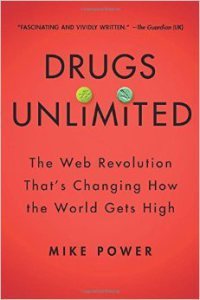 substances. Smoke and Mirrors: The War on Drugs and the Politics of Failure is an exhaustive, apolitical narrative history of the war’s origin, evolution and cost, and though public opinion has changed (a recent Pew Research study found that Americans now favor treatment over prosecution and are against mandatory minimum sentencing by a two-to-one ratio), the book remains an important document of the human toll of the drug war.
substances. Smoke and Mirrors: The War on Drugs and the Politics of Failure is an exhaustive, apolitical narrative history of the war’s origin, evolution and cost, and though public opinion has changed (a recent Pew Research study found that Americans now favor treatment over prosecution and are against mandatory minimum sentencing by a two-to-one ratio), the book remains an important document of the human toll of the drug war.
I bring up Baum’s work because Drugs Unlimited: The Web Revolution That’s Changing How the World Gets High, by UK journalist Mike Power, is its 21st century bookend. At the time Smoke and Mirrors was penned, the Internet was in its infancy, data transfer rate was measured in kilobytes and computer literacy was limited.
In the decades since, the Web has expanded the chemical landscape, altering which drugs we do, how we acquire them, and in an effort to stay a step ahead of the law, Power writes, producers, suppliers and consumers have shifted into the wildly erratic world of “research chemicals”—legal alternatives to and analogues of illegal compounds sold widely over the Internet.
The consumption of psychoactive plants is nothing new (the earliest known head trip dates back about 13,000 years), but until the 1970s and ’80s, recreational drug users had only a handful of chemicals to choose from. In 1971, the United Nations identified just 234 legal substances; 243 new compounds have been identified in just the past four years.
Accelerated culture, indeed.
These new chemicals are often untested, of shady origin and composition and can be far more lethal than their outlaw counterparts. They’ve also inspired media-invented “epidemics” of bath salts and synthetic marijuana—fueling a digital age reefer madness that keeps drug policy mired in the past.
But Drugs Unlimited is as much about hypertext transfer protocol as politics. The psychonauts who once explored inner-space have journeyed into cyberspace, and the market has moved from the corner to the CPU.
Power’s narrative is thorough and engaging, but at times can be too thorough, particularly when it comes to the chemical names. For example, Power is compelled to include a complete stock list from a chinese distributor, which includes more than 90 compounds with names like 5-MeO-DALT, Methiopropamine (MPA), Fluoromethamphetamine (and its analogues), Desoxypipradrol (2-DPMP) and so on.
Granted, he does this for effect: “Among that unreadable alphabet soup of drug names there are hallucinogens, stimulants, empathogens and cannabinoids. Working out which of them are legal or which have been outlawed in various countries would require thousands of hours of legal time or case law study.”
This certainly helps shed light on the challenges facing consumers and law enforcement, but at times, the emphasis on product names can be overwhelming.
Aside from that, Power crafts an accessible narrative that is one of the most important books of the millennium. What Baum did for the American drug war, Power does for the U.K., from the digital age to the Deep Web.
The Triangle: A Year on the Ground with New York’s Bloods and Crips
Kevin Deutsch
While Drugs Unlimited operates at a broad level, The Triangle goes micro. For a harrowing year, journalist Kevin 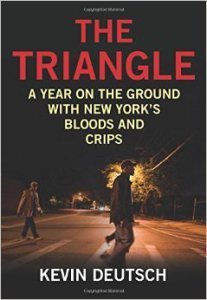 Deutsch shadowed the gang-bangers of Hempstead, Long Island, in a place known as the Linden Triangle—ground zero of a 2012 turf war that turned an already rough neighborhood into a slaughterhouse. Forget the stereotypes of suburban Long Island. Think The Warriors rather than The Great Gatsby.
Deutsch shadowed the gang-bangers of Hempstead, Long Island, in a place known as the Linden Triangle—ground zero of a 2012 turf war that turned an already rough neighborhood into a slaughterhouse. Forget the stereotypes of suburban Long Island. Think The Warriors rather than The Great Gatsby.
Dramatically reconstructed from interviews, legal records and first-hand experience, The Triangle is as fast-paced and action-packed as a first-rate thriller—a literary narrative as entertaining as it is troubling. The cast includes leaders, hitters and corner crews from both the Bloods and Crips; the terrorized residents of Hempstead; cops, criminologists and others in the justice system; and a minister who leads midnight prayer groups on the corners.
Deutsch stitches together their stories with a novelist’s skill. He’ll (rightfully) earn high marks in the press for his research and daring, but his ability to manage this Dostoyevskian cast without disrupting the narrative flow is worth noting.
Racial and social problems emerge that are intrinsic to the drug war. Incarceration and surrounding gentrification has turned Hempstead into an island of poverty. The gangs are the biggest employers in the Triangle, and those who would oppose the gangs are financially trapped in their territory.
Deutsch doesn’t give us an easy out. The reader is forced to confront the capriciousness of life in Hempstead, the social and legal conditions that created it and the self-defeating strategies of the gangsters that maintain a vicious status quo.
There is something heroic about the ability to survive in this environment, particularly in defiance of hateful neighbors (one Nassau County government official recommends that they “carpet-bomb Hempstead”: “Let the blacks and Hispanics go back to New York City. They’re better off there. Long Island isn’t that kind of place.”) Yet, Deutsch is wise to avoid romanticizing thug life, and not afraid to reveal the cowardice of its so-called soldiers:
Tyrek, leader of the Crips set, earned his membership by stabbing a pregnant teenager in the stomach. His ace card in the turf war is a suckerpunch, not a fair fight. J-Roc, a rising soldier in the Bloods, talks a big game, but struggles to intimidate a senior citizen. Ice, leader of the Bloods, helps promising kids get an education, yet orders the kidnapping and gang-raping of his rivals’ sisters, girlfriends and mothers.
Sadly, for all the lip service about honor, the Crips and Bloods mostly prey on the vulnerable. The true casualties of this war are the women in the crossfire. “The gangsters see sexual violence as a strategic and tactical weapon, as important to their arsenal as guns and blades,” Deutsch writes in the chapter “Extreme Tactics,” which includes the retaliatory abduction and gang rape of a female Crips employee.
At least the victim, in this case, actually works for the gang. That is not a prerequisite. Flex Butler, a Crips lieutenant, brags about assaulting the 15-year-old sister of a guy who’d stolen $2,000 worth of cocaine.
“‘[He] was hiding from us,’ Flex says. ‘So we got his sister when she was walking home from school. She fought hard, but there was a lot of us.’”
So yeah, these are not sympathetic characters. Deutsch doesn’t condemn, patronize, glorify or victimize, but presents the residents of Hempstead in all their unresolved moral complexity. For the most part, he avoids the cinematic histrionics common to gang narratives. The lone exception is D-Bo, a promising kid whose attempt to escape the corner gets a bit of the Hollywood treatment. Much is made of the timing of a confrontation with his gang (even though he’d been at home for a month), which leads to a chase scene, a misunderstood shooting and a dramatic exchange between the corner boy and the officer who tried to help him escape while awaiting the paramedics.
But I’ll forgive Deutsch this one instance of going for the heart strings. Otherwise, this is an unflinching look at the fear, fame and futility of gang warfare.
Strong writing, compelling characters and front-line reporting make this an entertaining read, but Deutsch’s detached, yet compassionate handling of the material makes The Triangle an important one as well.
Both Drugs Unlimited and The Triangle are worthy books on their own, but for anyone with a love of history, sociology or just damn good journalism, this is a one-two combination that, together, offers a wide perspective of the War on Drugs.

January 5, 2015
Review: Is There Life After Football?
Is There Life After Football?: Surviving the NFL
James A. Holstein, Richard S. Jones and George E. Koonce, Jr.
I couldn’t have known it at the time, but in one night I met two athletes who would become prominent figures in the modern NFL concussion narrative: Mike Webster and Jack Tatum. At the time, Tatum was recently retired, but Webbie was still playing for my hometown Steelers, and of the seven or so players I met at this banquet, these are the only two I remember.
Because I bleed black and gold, I was happy to meet Webster. I remember him being incredibly friendly, shaking hands with both my father and me and penning a thoughtful autograph. But as cool as that was, I was really excited to meet the notorious Tatum, the icon of NFL villainy for permanently paralyzing wide receiver Darryl Stingley.
This had earned Tatum one of the coolest sports nicknames of all time, and he was at this banquet promoting the first of his three autobiographies, They Call Me Assassin.
Tatum didn’t just look mean–the air around him chilled, the energy darkened. Something repulsive oozed off of him and kept the crowd at a distance. He didn’t crack a smile, had none of Webster’s warmth. When I handed him my autograph sheet he literally just signed his name. No message, no greeting. Just “Jack Tatum.” He was terrifying, and I came away from that encounter star-struck.
Of course, my opinions of both men are much different now.
Nevertheless, both men symbolize the celebrity and consequence of football’s golden age: Tatum the intimidating aggressor whose ferocity and win-at-all-costs mentality are prized attributes and Webster the tough-as-nails scrapper who attained on-field glory at the cost of his mind, body and dignity off of it.
In the past decade, we’ve learned about the long-term health risks of playing professional football. With every early death, suicide and descent into darkness and bankruptcy, it becomes more difficult to enjoy a Sunday slugfest with a clear conscience. In another two decades, we may not recognize professional football, because we’re just now recognizing the toll it takes on its players.
An important new book on the subject, Is There Life After Football?, considers not only the physical and neurological toll of the sport, but also the psychological impact of job-mandated violence, short careers, and the wild financial swings common among players.
Penned by two sociologists and an unexpected scholar (former Green Bay Packers star George Koonce–that is, Dr. George Koonce), Is There Life After Football? provides a sobering and insightful view of this transition through the personal anecdotes of Koonce and the research of Holstein and Jones. Most jarring is Koonce’s admission of a reckless act at the end of his career. It wasn’t exactly a suicide attempt, but he did drive his car off the road just to see what would happen.
This anecdote is all the more poignant when considering the recent driving death of Rob Bironas.
Though not as accessible as the prose styles of Malcolm Gladwell and Michael Lewis, the authors do a great job of distilling difficult material into a digestible form. It’s also a treat to read for anyone who enjoyed watching those plucky Packers of the 1990s. Juxtaposing those dynamic teams with Koonce’s experiences gives the book a Behind the Music vibe.
The takeaway is the same. Just as those we see on stage and screen are real people, so too are the men behind the facemasks.
Perhaps in a box, somewhere, at my parents’ house is a slip of paper with Webster and Tatum’s autographs. If I ever find it, I’ll frame it, perhaps donate it to a museum, where it can memorialize a different time, alongside bare-knuckle boxing and Crack the Whip as American pastimes whose time has passed.

December 31, 2014
Best of 2014
Happy New Year, coming to you live from gate B-11 at Charlotte Douglas International Airport (en route from Pittsburgh to Denver).
Tis the season for arbitrary year-end best-of lists. Even the New York Times, with its battalion of bookworms, can’t cover and judge all new titles. I read more than 50 books this year, more than 30 of which were new releases. From this tiny sample, how can I present a definitive list of best books of the year?
What I can do is highlight the finest books that reached my nightstand or my Nook. So here, in no particular ranking, are my top reads of 2014.
Spectacular Science Writing
The Humor Code: A Global Search for What Makes Things Funny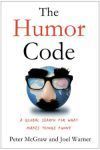
Joel Warner and Peter McGraw
“We’re here to explore the dark side of humor, how comedy can divide and degrade,” write Warner and McGraw. “Here,” in this case, is Denmark, but also Japan, Palestine, Peru and beyond. For more than two years, this odd couple of comedy—Warner a journalist (Westword, Wired, Slate) and McGraw a humor researcher/marketing instructor (at the University of Colorado at Boulder)—traveled the world to learn what incites nasal milk projectiles in other cultures.
Specifically, the intrepid twosome tested whether McGraw’s Benign-Violation Theory (BVT) of humor applied to an international audience.
For that, Warner and McGraw visit a humor science library in Japan; deliver clown therapy to a Peruvian barrio alongside Patch Adams; interview notorious Danish cartoonists; participate in laughter yoga (yes, that’s a thing); attend comedy festivals; and McGraw even gives stand-up comedy a try in Denver’s toughest room.
That’s a lot to fit into a single book, but you’ll want to read every word. The Humor Code is an engaging blend of science writing, travel writing and narrative nonfiction. This is one of the best books you will read this year, and it is deserving of major awards.
The Tale of the Dueling Neurosurgeons
Sam Kean
The Tale of the Dueling Neurosurgeons is a brisk and engrossing read, and Sam Kean’s most impressive yet. He digs deep into the archives of psychology to discover little-known and sometimes forgotten gems that have had a great impact on modern science. You will laugh. You will learn. At times you will pick your jaw off the floor and ask yourself, “That happened?”
If you’ve never read Sam Kean, start now. You will devour all three of his books in a week. If you’re a longtime fan, prepare to be wowed once again.
And if you’re a judge for any of the big literary prizes, in the name of all that is just and good, start etching Sam’s name into the trophy.
Faith and Wisdom in Science
McLeish explores the history of both scientific discovery and biblical narrative, finding commonalities in the ways humans in each arena are awestruck and inspired by the natural world. There is room, he argues, for the sublime in science. The earliest scientific studies were not the cold, heavily controlled research we have today, he writes, but passionate probes of the natural world. There has since developed a rift between the science and humanities. Science got custody of the brain in the divorce, and humanities, the heart.
If you still feel the sublimity of mountain peaks, marvel at existence at the subatomic level or can be moved to tears by a sunrise, you’ll enjoy Faith and Wisdom in Science.
Dystopian Literature
Justice, Inc.
In the introduction to his short story collection, Justice, Inc., Bridges prepares us for the satirical rapture he is about to unleash: God, discouraged by his failed attempts to kill off the human race, comes to the realization that “…when left to their own devices, they appeared to do a fair job of exterminating themselves.”
And thus the chain catches on the death-coaster, drags it to the summit and lets that fucker drop.
Hang on.
These are masterful tales of human obsolescence, cruel absurdities and species self-deliverance. In Bridges’ world, justice is self-imposed, whether or not his characters realize it. You want the convenience and savings of a Wal-Mart? Fine, but you have no one else to blame when you wake up in a world controlled by Wal-Marts. Punishment fits the crime.
Justice, Inc. manages to be both observational and engaging, philosophical yet lyrical at the same time. You’ll find yourself caring as much for the characters and their plights as for the underlying philosophy within each tale.
Bridges writes not with a pen but a skewer, piercing the absurdity of our cosmic sitcom with clarity and humor. Justice, Inc. is philosophical satire in the vein of Vonnegut and George Saunders—fellow madmen who have stared into the abyss and come away laughing.
Ominous Realities
Eds. Anthony Rivera and Sharon Lawson
Once again, Grey Matter Press has delivered the anthology goods. Take “On the Threshold,” an eerie, Lovecraftian tale of science and madness from William Meikle. Keeping up the intensity is “Doyoshota,” by Ken Altabef, a haunting intersection of conspiracy and cacophony that makes tinnitus sound like a Beethoven sonata.
Eric Del Carlo’s “We Are Hale, We Are Whole” is deserving of any “best-of” anthology, a smart, thoughtful piece of writing that should be a must-read for anyone attempting to world-build within the confines of a short story. It also takes a philosophical bent about quality of life, aging, health care and sacrifice.
Best Biography
Happy Clouds, Happy Trees: The Bob Ross Phenomenon

Kristin G. Congdon, Doug Blandy and Danny Coeyman
Beloved painter Bob Ross is all the more mysterious for the minimal amount of unauthorized or paratextual materials surrounding him. Mostly, what we know of Ross comes from his TV program. The mystique of the painter’s life has fueled his cultish following, and the authors do a wonderful job of exploring the man, his devotees and that ineffable thrill of creation. Bob had a word for it.
He called it joy.
An Infuriating American: The Incendiary Arts of H.L. Mencken
The tone of this extended essay is established up front by a quote from the subject himself, H.L. Mencken:
“To the extent that I am genuinely educated, I am suspicious of all the things that the average citizen believes and the average pedagogue teaches.”
Mencken, one of America’s finest journalists, was also a world-class iconoclast, and the tone and spirit of his work is captured wonderfully in this short study by Hal Crowther, himself an esteemed author (and 1992 recipient of the H.L. Mencken Award). Mencken should be required reading for everyone (particularly prospective journalists), and An Infuriating American is as good an introduction to the writer as you’ll find.
The Mad Sculptor: The Maniac, The Model, and the Murder that Shook the Nation
“You can certainly learn as much about a society by which crimes people are obsessed with at a particular time,” says Schechter. “I think, in a general way, the crimes that become national obsessions, that strike a deep communal chord, symbolize the particular cultural anxieties of the moment.”
In the 1920s it was poisoners; in the ’70s Charles Manson personified the worst fears of the counterculture; the ’80s had phantom Satanists and the ’90s belonged to the serial killer; and today we have the rampage shooter.
But in the 1930s, it was the sexual deviant that haunted and titillated the public.
Enter Robert George Irwin, the subject of Schechter’s new book.
Irwin was a troubled and talented artist whose stunted psychosexual development (and religious obsession) fueled romantic fixations, violent outbursts, numerous hospitalizations and an attempted self-castration. It climaxed with a vicious triple murder in 1937, made all the more newsworthy because one of the victims, Veronica Gedeon, was a pulp magazine cover girl.
Notable Nonfiction
Rock ‘n’ Roll Soccer: The Short Life and Fast Times of the North American Soccer League
The groundwork for today’s soccer popularity was laid by the North American Soccer League, the subject of Rock ‘n’ Roll Soccer. Plenderleith documents the folly, effrontery and ultimate failure of the NASL—an impressively thorough tome that benefits from solid research and a witty outsider’s perspective (though now living in America, Plenderleith is British and brings a European’s passion and insight to football writing).
Rock ‘n’ Roll Soccer is an excellent work of sports journalism and, regardless of whether you follow football or futbol (or both), it is worthy of any fans’ bookshelf.
 The Perfect Kill: 21 Laws for Assassins
The Perfect Kill: 21 Laws for Assassins
Robert Baer
It was not hard to get me to pick up The Perfect Kill. Advice on how to pull off a flawless assassination? From a CIA insider? Sign me up. But before you begin stockpiling your arsenal, don’t think of this as a modern-day Anarchist Cookbook, but rather an engaging work of military history—an insider’s view of the Middle East through the eyes of an assassin.
While the subject matter alone is interesting, Baer’s writing makes this a thrilling read from start to finish. He has a narrative voice that is concise, informative and though he occasionally drifts toward the conspiratorial (which isn’t a bad thing), he tempers it by clearly defining what is fact and what is conjecture.
Illuminating Lit
Beautiful You
Palahniuk took on male malaise with Fight Club and mocked cultural over-consumption with Choke. Snuff (ostensibly a novel about pornography) lampooned self-destructive excess and exploitation in a manner that could very well have served as a hyper-sexualized predictor of the impending financial crisis of 2008.
In Beautiful You, he wanted to write what he calls gonzo erotica, and in the process has penned an anthem for an overstimulated, multi-tasking, computer-coma society.
Penny Harrigan is a nice Nebraskan girl working in New York City when she catches the eye of the world’s richest man, C. Linus Maxwell. Next thing you know, Penny is the talk of the tabloids and the envy of her coworkers.
Behind closed doors, however, is where Penny is truly transformed. Maxwell introduces her to a world of unimagined, if clinical pleasure. Penny has her reasons to question Maxwell’s motives (especially after a bizarre bathroom tryst with his bitter ex-lover), but is too enraptured with her new-found fame and sexuality.
Oozing with plot twists only Palahniuk’s sardonic tone could make palatable, Beautiful You aspires to remarkable levels of absurdity, but is it any more absurd than the daily inundation of product and marketing? Many reviewers have criticized the gratuitous satire in this novel, but is the idea of world domination via dildo really that far-fetched in a culture that has financially sustained multiple cable shopping channels for three decades?
We are a culture of instant gratification. We are a culture of distraction. We are the lab rats hammering away at the pleasure bar for a taste of sweet, sweet oblivion.
And much like Maxwell, Palahniuk is there wearing a lab coat, taking copious notes and holding up a funhouse mirror to our cage, so that we might catch a distorted glimpse of what we’ve become.
The Children Act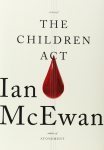
Ian McEwan
Fiona Maye is an experienced judge on the cusp of old age who is questioning her lifetime of restraint (as well as her decision not to reproduce). We enter her story mid-conversation to discover Fiona reeling from her husband’s proposed (and possibly in-progress) infidelity, just as she’s preparing for a high-profile case with a child’s life in the balance.
Cut to the courtroom, where a precocious teenager is refusing a blood transfusion on the grounds of being a Jehovah’s Witness. Invoking the Children Act of 1989, Fiona gives her ruling, the consequences of which ultimately lead to a spontaneous, classically McEwan mistake, one that risks undoing her marriage, her career and a lifetime of calculated decision-making.
The Children Act is a short, but dense novel, as is usually the case with McEwan. The man is a master of reflection and interiority. The opening chapter encompasses but a moment in a 30-year marriage, but lays bare its successes, failings and a lifetime of insecurities and second-guessing. The tragedies unfold in slow motion and a lifetime of torment is distilled into a bitter, lingering moment.
Quality Quickies
We Should All Be Feminists
This brief and brilliant essay (it comes in around 20 pages) from the celebrated author of Half of a Yellow Sun, is one of the most interesting pieces I’ve read all year. “Feminist” is a word long-since stripped of its original meaning: politicized, glorified, demonized. It’s got more ill-fitting baggage than an overhead compartment. Adichie cuts through the connotations to get at the core value of feminism and how it celebrates and benefits both men women.
It’s a call to arms to imagine a generation of children raised without the biases that, consciously and unconsciously, perpetuate gender norms. It’s a call to rethink masculinity so that the next crop of men grow up healthier than the last. It’s a call for all of us to “do better.”
The essay may be short, but the conversation it generates is long and important.
Legion: Skin Deep
StephenLeeds is afflicted with a mental disturbance wherein he has imaginary friends who enable him to solve crimes. His mental manifestations, which he calls “aspects,” have names, back-stories and seemingly a life of their own, though they are bound by the limits of Leeds’ finite knowledge and experience.
In Skin Deep, the second novella in the series, Leeds is coerced into locating the corpse of a tech worker who was in possession of dangerous information—while at the same time outwitting a devious businessman and avoiding the strike of a first-rate assassin.
What makes the Legion books so amazing is not so much the outer conflicts, but the inner ones. Who are we? How do we define who we are? Would we all be better served to, ahem, use our illusions? These are the deeper strings Sanderson plucks in the Legion series.
May there be many, many more.
Horrific Hits
The Winter People
What is it about New England that inspires isolated, small-town horror tales in which the blood runs as cold as the weather? I’m not sure what it is exactly, but having spent many a wintry a night in Maine, I am familiar with that feeling. And I can’t get enough of it.
Jennifer McMahon captures that frostbite feeling perfectly in this heartbreaker of haunted legends and legacies, curses and karma, and, more than anything, unendurable loss.
The Winter People is well-written and bursting with heart. There are mysteries at every turn, and reminders that grief can be deadly. Or worse. Like a modern retelling of “The Monkey’s Paw,” there are consequences for disrupting the dead, and The Winter People reminds that despair can drive even the most sensible among us to dangerous depths.
Ten Short Tales About Ghosts
Typically, the hallmark of a great ghost story is that it unsettles the reader. When reading K.C. Parton’s collection of English ghost stories, however, one is filled not with dread, but comfort. These 10 tales are reminiscent of the kind my father would tell me over campfires—and those, of course, will always be my favorites.
Parton’s stories have that same appeal. These are not tales of terror, but subtle chillers made all the more spooky for their familiarity. Stories that make you think twice before cutting through the graveyard, not to avoid falling prey to a Saw-like killer, but for that abstract fear that tickles as much as it terrifies.
A big draw for me is that most of the stories have an industrial setting. Growing up in the Rust Belt, I was exposed to the real-life horror of the steel mills, and I found much ghostly inspiration in the rusted machinery, secluded warehouses and the imaginative possibilities of the graveyard shift. Parton’s stories fit that mold, which shouldn’t be surprising, as he came of age in England’s post-war factories.
These stories tap into that primal need for campfire tales—the kind that give goosebumps, sure, but leave you smiling in the end.
The Cutting Room
“With no dreams left to search for, I have only nightmares to anticipate.”
This is one of the most haunting lines from the tremendous opening story, “The Cutter,” by Edward Bryant. It sets the tone for all the delicious horror in Ellen Datlow’s latest anthology. Disturbing images and the blurring of reality is a common theme in this collection. Stephen Graham Jones’ chilling “Tenderizer,” for example, David Morrell’s “Dead Image” and the wonderfully titled “Filming the Making of the Film of the Making of Fitzcarraldo” by Garry Kilworth.
Anticipate many nightmares within these pages.

December 23, 2014
Review: Legion: Skin Deep
Brandon Sanderson
Legion: Skin Deep
Not long ago, I sang the praises of Sanderson’s novella Legion (http://ensuingchapters.com/2013/01/03/review-legion/), a mystery tale centered around the brilliant, unquiet mind of Stephen Leeds.
Leeds is afflicted with a mental disturbance wherein he has imaginary friends with benefits (no, not that kind, pervo, though two of his manifestations are going through a difficult breakup in this installment). His mental manifestations, which he calls “aspects,” have names, back-stories and seemingly a life of their own, though they are bound by the limits of Leeds’ finite knowledge and experience.
Consider it a cross between schizophrenia, dissociative identity disorder and unconscious cognition.
Put simply, like all of us, Leeds can access a limited portion of the information he receives from external stimuli, but he’s also able to access the subconscious bits via imaginary personalities. The result is a skill set unmatched by any other detective in literature. (Leeds isn’t a detective per se, but like fellow troubled genius, Sherlock Holmes, often finds himself consulting on cases).
In Skin Deep, the second novella in the series, Leeds is coerced into locating the corpse of a tech worker who was in possession of dangerous information—while at the same time outwitting a devious businessman and avoiding the strike of a first-rate assassin.
As before, the plotting and character development is astounding. I listened to the audio version, and devoured it in two sittings (it would have only been one were it not for work). Once again, Oliver Wyman’s narration is poetry. He inhabits all of Leeds’ imaginary allies as well as his very real adversaries, shifting seamlessly and convincingly through various genders, races and personalities.
But this is more than a groovy mystery; Sanderson uses Leeds as a launch-pad for theological debate. I believe he handled the religious discussion better in the first Legion story, while in Skin Deep, the tone is didactic. Leeds describes himself as “15 percent atheist,” aggregating the beliefs of his various aspects. This is a clever way of exploring the inner conflict between doubt and faith, illustrating our tenuous grasp of knowledge and belief.
What makes the Legion books so amazing is not so much the outer conflicts, but the inner ones. I never subscribed to the academic taboo on having characters with mental illness (because it’s reductive, or some other scholarly jargon). Leeds cannot be reduced to any one of his aspects, just as his consciousness is more than the sum of his personalities. He is capable of change. We see it both within and between the books.
Perhaps Leeds’ greatest fear is that he will someday be free of his aspects, because I think he’d be lost without them. In his more existential moments, Leeds wonders whether he is simply someone else’s aspect, eliciting that dissociative tingle we’ve all felt at various times.
Who are we? How do we define who we are? Would we all be better served to, ahem, use our illusions? These are the deeper strings Sanderson plucks in the Legion series.
May there be many, many more.

December 15, 2014
Noir Noel
From hard luck to hard science, this trilogy of thrillers will dim the holiday lights of the noir fanatic in your life. Much like the three wise men, we offer gifts of the gritty, the procedural and the other-worldly.
The Forgotten Addiction
Michael Lion
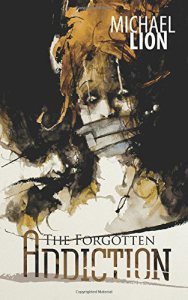 If you’ve got someone on your shopping list who likes it fast and dirty, gift them this hard-boiled holiday treat. In the follow-up to Lion’s acclaimed debut, The Butcher’s Granddaughter, Bird is back and looking for redemption. Fans of the genre will love Lion’s furious pacing and tightly wound prose.
If you’ve got someone on your shopping list who likes it fast and dirty, gift them this hard-boiled holiday treat. In the follow-up to Lion’s acclaimed debut, The Butcher’s Granddaughter, Bird is back and looking for redemption. Fans of the genre will love Lion’s furious pacing and tightly wound prose.
The setting is interesting as well: 1993 Los Angeles (a wild time in the City of Angels). No cell phones. No Google. Just Bird the snitch playing both sides of the street and trying to find the missing daughter of a man murdered right before his eyes.
The search is both exciting and existential.
The strength of The Forgotten Addiction is Lion’s ability to create tight, gritty prose, but for all the textual skill, his characters are too familiar. Bird gives everyone a bad attitude, whether or not he’s provoked. Readers will recognize the upwardly mobile prostitute who is using her income to fund her education; the tough but noble bouncer who moonlights for Bird; the befuddled psychiatrist who is outwitted by the snitch.
Some of the plot turns are too convenient, but the action (and salty interaction between characters) is worth the ride. I couldn’t stop reading from one chapter to the next, and the narrative never grows stale.
It’s also fun to go back to that time and place when the west was on fire. This is one of the season’s best releases.
Case Closed
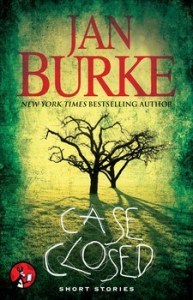 Jan Burke
Jan Burke
For two decades, Burke has thrilled a wide audience (including Bill Clinton) with her series of novels set around journalist Irene Kelly. Over the years, fans have enjoyed her blossoming romance with detective Frank Harriman, but in Case Closed—the last of six ebook collections pairing Burke’s new short fiction with stories from her anthology, Eighteen—we meet Harriman as a bumbling rookie. In this tale, he responds to a missing persons call, all the time wondering why the other cops are treating it with such cynicism. And it only gets stranger from there. Burke’s skill for dialogue and wit shine through. The interaction between Harriman and the old lady is delightful. There is a glaring plot hole in the big reveal (I won’t spill it, but it’s safe to say even the laziest, most cynical cop would have thought to check there), but it doesn’t spoil the enjoyment of the story, nor the others in the collection. It’s a wonderful introduction to Burke’s underworld.
Dangerous Games
edited by Jonathan Oliver
Incorporating mystery, horror and sci-fi, this eclectic anthology has something for everyone. Leading off with 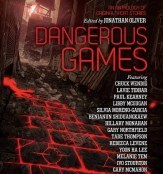 heavyweight Chuck Wendig and his dark tale “Big Man,” Dangerous Games plays on the theme of, well, games of course, but also chance, circumstance and, by extension, chaos theory (sort of). Wendig sets the tone with a dark yarn about road rage—a game we’ve played at some time, and it has no winners. Other standouts include offerings from Silvia Moreno-Garcia, Libby McGugan and Gary McMahon. Stories take us to the twisted future and the tortured past, but regardless of setting, each tale gnaws at the insatiable itch we have to roll the dice—and suffer the consequences.
heavyweight Chuck Wendig and his dark tale “Big Man,” Dangerous Games plays on the theme of, well, games of course, but also chance, circumstance and, by extension, chaos theory (sort of). Wendig sets the tone with a dark yarn about road rage—a game we’ve played at some time, and it has no winners. Other standouts include offerings from Silvia Moreno-Garcia, Libby McGugan and Gary McMahon. Stories take us to the twisted future and the tortured past, but regardless of setting, each tale gnaws at the insatiable itch we have to roll the dice—and suffer the consequences.

November 3, 2014
Review: An Infuriating American
An Infuriating American: The Incendiary Arts of H.L. Mencken
Hal Crowther
The tone of this extended essay is established up front by a quote from the subject himself, H.L. Mencken:
“To the extent that I am genuinely educated, I am suspicious of all the things that the average citizen believes and the average pedagogue teaches.”
Mencken, one of America’s finest journalists, was also a world-class iconoclast, and the tone and spirit of his work is captured wonderfully in this short study by Hal Crowther, himself an esteemed author (and 1992 recipient of the H.L. Mencken Award). Mencken should be required reading for everyone (particularly prospective journalists), and An Infuriating American is as good an introduction to the writer as you’ll find.
Crowther’s prose is fearless in tone and content. He is willing to editorialize and present Mencken in all his contradictions—and he doesn’t shy away from the difficult subjects, like racial discrimination. For all his bluster about defying popular opinion and pedagogy, Mencken was a sheep when it came to racism. His comments about Jews and African-Americans, as well as his complicated love affair with Germany post-WWI, are indefensible, and Crowther makes no effort to do so.
But that shouldn’t come as a surprise. Mencken drew the ire of many and never held his tongue to avoid criticism. He was an elitist and, one could argue, a misanthrope. “Human progress was one of the myths to which Mencken did not subscribe,” writes Crowther.
I would say the evidence supports this decision.
The breadth of his thought is such that members of all political factions can claim Mencken as one of their own. Crowther establishes his proper place: “Certainly Mencken was a conservative by many measures, and died conspicuously to the right of the intellectual mainstream. But it’s a grievous insult and injustice to imagine him watching Fox News, or celebrating the wisdom of Rush Limbaugh and Ayn Rand.”
This is a wonderful book about a complicated man, and an important object lesson for anyone pursuing a career in journalism, writing or general rabble-rousing.
And during this political season of partisan blowhards and neutered media, is there anything more fitting (or even patriotic) than revisiting an era of bold journalism, back when it was a blue-collar profession of integrity, and not something best illustrated by the film Nightcrawlers.


November 2, 2014
Review: The Perfect Kill
The Perfect Kill
Robert Baer
It was not hard to get me to pick up The Perfect Kill: 21 Laws for Assassins, by former CIA case officer and best-selling  author Robert Baer. Advice on how to pull off a flawless assassination? From a CIA insider? Sign me up.
author Robert Baer. Advice on how to pull off a flawless assassination? From a CIA insider? Sign me up.
But before you start stockpiling your arsenal, don’t think of The Perfect Kill as a modern-day Anarchist Cookbook. This is an engaging work of military history—an insider’s view of the Middle East through the eyes of an assassin.
The assassin, though, is not Baer, but rather Hajj Radwan (aka Imad Mughniyeh), a notorious Lebanese terrorist affiliated with Hezbollah and the Islamic Jihad Organization. He is the man responsible for the 1983 suicide bombings of the U.S. embassy and marine barracks, and Baer links him to a number of kidnappings, hijackings and assassinations in the 1980s and ’90s.
Despite being an international fugitive (he was on the “most wanted” list of dozens of countries) and the focus of numerous arrest and assassination attempts by the U.S. and Israel, Radwan was able to execute successful terrorist attacks for a quarter-century before being killed by a car bomb in 2008.
His ability to elude justice for so long is frustrating to fans of instant karma, but for an experienced CIA operative (Baer himself was in pursuit of Radwan), he authored a playbook for political murder.
While the subject matter alone is interesting, Baer’s writing makes this a thrilling read from start to finish. He has a narrative voice that is concise, informative and though he occasionally drifts toward the conspiratorial (which isn’t a bad thing), he tempers it by clearly defining what is fact and what is conjecture.
And Baer’s got the bona fides to back it up. He writes for Time and other news outlets; he has produced documentaries for the BBC; and he has authored nonfiction best-sellers like See No Evil and Sleeping with the Devil.
Oh, and George Clooney played Baer in Syriana. Not a bad resume.
Each chapter begins with a “rule” for assassins, such as “The Bastard Has to Deserve It” (Law #1), “Every Act a Bullet or a Shield” (Law #4) and “Nothing Wounded Moves Uphill” (Law #20). Also included are “notes” to help one stick to each law and historical lessons (successful and otherwise) enforcing its importance.
But always, the primary narrative is the chess match between Bear and Radwan, and it is one that spans decades and continents. It’s a fascinating tale, and not surprisingly, the TV rights to the book were sold months before its publication.
I’m excited to see its adaptation, but there’s no substitute for the source. This is a stellar book that is a must-read for fans of history, the Middle East, the military and U.S. foreign policy.


November 1, 2014
Review: The Cutting Room
The Cutting Room
Ellen Datlow, editor
“With no dreams left to search for, I have only nightmares to anticipate.”
This is one of the most haunting lines from the tremendous opening story, “The Cutter,” by Edward Bryant. It sets the tone for all the delicious horror in Ellen Datlow’s latest anthology, The Cutting Room: Dark Reflections of the Silver Screen.
Those familiar with Datlow’s work know that she is the go-to authority in the horror/fantasy world. The appeal of any anthology is the prospect of finding some good stories and maybe discovering new authors, but buyer beware: Anthologies themselves can be hit and miss, especially when the stories are crudely arranged with no thought to pacing or theme.
When Datlow’s name is on the cover, however, you know the collection will contain the highest quality writing and arranging, kind of like listening to a Rob Gordon mix tape (or Rob Fleming, for those who prefer the novel version of High Fidelity).
The genius of starting this anthology with Bryant’s “The Cutter” is that:
It is set in a movie theater
It features a film projector, Mr. Carrigan, who cuts and splices the incoming films so that attendees at his theater have a different version of the film than the director intended
It thrusts the reader into a world of altered reality, where nothing is beyond edit and where nothing can be believed or counted on besides death
Of course, I’m a little biased. Not long after I moved to Colorado, Westword profiled Bryant and his fiction, and I’ve been a fan ever since.
Datlow refuses to let off the gas with the next tale, “The Hanged Man of Oz” by Steve Nagy, which plays upon the belief that an on-screen suicide is visible in The Wizard of Oz. I happen to share this belief, though it is denied by some. Nagy’s version gets even crazier, with the protagonist haunted by the scene, the film, the characters and his new girlfriend, who’d shown it to him.
There are also stellar contributions from horror legends, such as Dennis Etchison’s “Deadspace” (in which a small-time producer encounters big-time creepiness), and relatively new talents like A.C. Wise’s “Final Girl Theory.” (To enjoy a wonderfully haunting audio version of “Final Girl Theory,” visit Pseudopod.)
I’ve long loved the Gemma Files and Stephen J. Barringer tale “each thing i show you is a piece of my death,” which I first read in Datlow’s The Best Horror of the Year, Volume Two. While I love the meta-everything tone of the piece, I have mixed emotions about the title. It’s a line from my favorite Marilyn Manson song, “The Reflecting God,” and I appreciate the reference, but it’s such an obscure line (from neither chorus nor verse, but rather spoken beneath a wall of power chords segueing into an instrumental break) I’m not sure enough people will get the reference. Still, it’s a great story (and a great song).
Of a similar tone is Gary McMahon’s “Cinder Images,” which reminds the reader why many of us love horror in the first place: “You try to close your eyes but you cannot. You have to see—you need to see this. There are things that must be endured, sights that cannot be ignored.”
In fact, the idea of disturbing images and the blurring of reality is a common theme in this collection. Stephen Graham Jones’ chilling “Tenderizer,” for example, David Morrell’s “Dead Image” and the wonderfully titled “Filming the Making of the Film of the Making of Fitzcarraldo” by Garry Kilworth.
The final story, “Illimitable Dominion,” is a wonderful story I’d read before (in a Datlow collection dedicated to Poe), but was worth a second read. It re-imagines the complicated relationship between Poe and filmmaker Roger Corman (a creative relationship, that is, not an actual one). By one view, Corman did the world a service by keeping Poe’s stories in the cultural conversation via horrid retelling of his tales. By another view, he also bastardized much of the master’s works, in ways inconceivable to Poe fans.
Newman’s story offers an alternate view, one that loosely weaves fiction with history.
Like any anthology, it’s unlikely that every story will resonate with all readers, but as far as quality is concerned, The Cutting Room is a major success. Even if you only read “The Cutter,” this monster matinee is worth the ticket price.
Anticipate many nightmares within these pages.


Review: The Children Act
Ian McEwan
The Children Act
Given one word to describe Ian McEwan, I’d have to go with excruciating. The tone (elevated and eerie) and density of his novels (to a degree that will try passive readers) ooze with  anxiety. His protagonists suffer quietly, haunted by a single instance of poor judgment or an absent-minded transgression.
anxiety. His protagonists suffer quietly, haunted by a single instance of poor judgment or an absent-minded transgression.
It’s all about moments and forbidden thresholds, the composed intellectual who discards dignity and custom to follow an animal impulse. Be it a father’s momentary lapse in The Child in Time, the sudden violence of The Innocent or the chilling cowardice in Amsterdam, there comes a dissociative moment in every McEwan novel in which a main character is forced to confront their darkest depths.
And then live with the consequences.
Such is the case for Fiona Maye, protagonist of The Children Act, McEwan’s latest novel. Fiona is an experienced judge on the cusp of old age who is questioning her lifetime of restraint (as well as her decision not to reproduce).
We enter her story mid-conversation to discover Fiona reeling from her husband’s proposed (and possibly in-progress) infidelity, just as she’s preparing for a high-profile case with a child’s life in the balance.
Cut to the courtroom, where the precocious teenager is refusing a blood transfusion on the grounds of being a Jehovah’s Witness. Invoking the Children Act of 1989, Fiona gives her ruling, the consequences of which ultimately lead to a spontaneous, classically McEwan mistake, one that risks undoing her marriage, her career and a lifetime of calculated decision-making.
The Children Act is a short, but dense novel, as is usually the case with McEwan. The man is a master of reflection and interiority. The opening chapter encompasses but a moment in a 30-year marriage, but lays bare its successes, failings and a lifetime of insecurities and second-guessing.
McEwan applies this level of care and detail throughout the novel, which may lack the sinister urge of books like The Cement Garden, The Comfort of Strangers or First Love, Last Rites, but certainly channels the disquiet of Enduring Love and Saturday, in which the tragedies unfold in slow motion and a lifetime of torment is distilled into a bitter, lingering moment.




